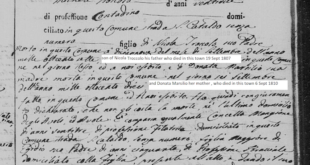At some point in your research, you have unearthed everything you need about the relatives you’ve know personally, and now you’re working on finding out about their parents and grandparents. These are folks who died before you were born or never left Italy and, as a result, you never met them. With no direct access, you must rely exclusively on Italian records to find the birth, marriage and death information on grandma’s grandparents.
So if you don’t have the beginning of a clue regarding what year to look for, how do you start? Step one is that you need to know the birth year of at least one of a particular family born in Italy. Your grandparent was born, for example, in 1905. But you know his older brother was born in 1901. This is the oldest sibling you know about, so you should start there.
If you can find the birth record of the eldest sibling, you might be lucky enough to find the age of that person’s father. (The age of the mother will only rarely be on the birth record of their child). If the baby was born at home, the father might be listed near the top of the birth record along with his age. This helps establish when he might have married.
If you can’t find the birth record right away, that’s ok too. You can order the microfilm of the marriages, and work backward starting with the year of birth of the oldest sibling. The worst case is you’ll have to search 20 years of marriages, but most likely you only need to look through a few years or so. The marriage is very critical because it will give you the parents’ names of both the bride and the groom, which gives you four more ancestors if you don’t already know them. It also gives you the birth towns of the bride and groom, which might be different. They might not come from the same town.
Now that you know the exact year of the marriage, we want to check a special set of records for that year know as either “allegati” or “processetti”. These are supporting documents that were filed in preparation of the marriage. These records can save us a lot of time, if you are lucky enough that they exist in your town and have been microfilmed.
Each marriage that year has a file in the allegati, usually with a handwritten title page. The documents are not always in any order, but the files are usually in order by the date of the marriage. So if someone is married in October, it will be toward the end of the allegati for that year.
There will almost always be an “estratto” of the birth records of the bride and the groom. This is a copy of each record, whether they are from this town or not. I have found birth records from America and Brazil in Italian allegati files, as well as records of people born in the nextdoor village or even the next province. I have found birth records for people born before the actual birth records begin for that town! One relative who was in his 70s married in 1876 and his birth and baptism were extracted from the parish records from 1802.
The marriage record will usually indicate if the parents of the bride or groom are alive or deceased. They will refer to the father of the groom as “di Vitantonio” if Vitantonio is living at the time of his son’s marriage. It may refer to him as “fu Vitantonio” if Vitantonio had already died. If any of the four parents are deceased, the allegati will include an “estratto” of the death record of that parent. This is a major time saver!! Death records are the hardest to search for when you have no idea when someone died and you have to search year by year. The death records included in the allegati can be copies from the father of the bride dying in a mining accident in Minnesota, or the mother of the groom dying in childbirth in your town in Italy.
If either the bride or groom was widowed prior to this marriage, instead of the parents, the records will instead include a copy of the “estratto” of the death record of the previous spouse. I wish they also included the parents but they usually do not.
The allegati usually includes a copy of the banns, which don’t really have much more information on them than the marriage record does.
It depends what part of Italy you are looking at, to know how well the allegati records were kept. My area in Bari have some years missing and some records missing from certain years, but are mostly complete from 1866 to 1929. Some provinces such as Basilicata have allegati for all years from 1809 to present. Some don’t have them at all.
Check the family history library catalog at www.familysearch.org for your town. If your family is from any town in Bari, use my finding aid.
http://www.rootsweb.ancestry.com/~itappcnc/bari/barifilm1.htm
Let me know what you find by writing to italianroots@comcast.net and please put “Fra Noi” in the subject line.
 Fra Noi Embrace Your Inner Italian
Fra Noi Embrace Your Inner Italian








If I wish to order allegati or marriage microfilm records, to whom do I address my request? Is there a standard format and perhaps a fee that I need to be aware of? Thank you.
How do I find a birth father whose name I know along with those of my sister and brother, but I’m in another country and I never met any of them?